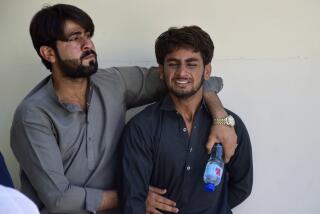Maoists in eastern India kill 70 soldiers
- Share via
Reporting from New Delhi and Phnom Penh, Cambodia — Maoists in eastern India killed at least 70 paramilitary soldiers Tuesday, authorities said, underscoring the continued strength of an insurgency that India has tried for decades to wipe out.
The dawn attack in Chhattisgarh state was among the deadliest in memory. S. R. Kalluri, a deputy police inspector in densely forested Dantewada district where the attack occurred, told local media that the soldiers were on an extended overnight patrol and stopped Monday night to rest.
At some point, insurgents learned of their location and “at the break of dawn the Maoists attacked,” Kalluri said. “Now we are chalking a strategy to retaliate.”
Several thousand people have died in attacks since the Maoist insurgency began in the late 1960s. Maoist fighters are said to number around 20,000, including an estimated 6,000 hard-core combatants.
In recent months, they have stepped up their attacks in response to a police offensive initiated late last year across several “red corridor” states.
On Sunday, rebels set off a land mine that killed at least 10 members of an elite anti-Maoist unit in the mineral-rich eastern state of Orissa.
The rebels are funded in part by hundreds of millions of dollars extorted from companies each year. Their arsenal includes automatic rifles, shoulder-fired rocket launchers, mines and related explosives, some of which have been stolen from Indian authorities and some purchased from Chinese smugglers.
The Maoists, who say they are fighting for poor farmers and landless workers, are particularly strong in impoverished, rural areas where basic government services are limited and local corruption is endemic.
Even as India’s expanding middle class struts its stuff in the cities, clogging roads and crowding shopping centers, vast swaths of the country have not shared in their gains.
Home Minister P. Chidambaram said there was an evident intelligence failure that saw the patrol, a joint operation of state and central-government forces, walk into a trap. Monday night was reportedly the third night that the paramilitary units had been camping out in remote jungle terrain.
“I am deeply shocked at the loss of lives,” he said. “This shows the savage nature of [the Maoists], and their brutality, and the savagery they are capable of.” Police spokesman R.K. Vij estimated that 1,000 rebels took part in the attack, while others put the number closer to 300.
While the state has claimed progress in its several-month-long “Operation Greenhunt” campaign against the Maoists, the number of attackers and their ability to avoid detection suggests the government faces a tough fight ahead. More than 1,000 attacks, resulting in 600 deaths, were recorded last year alone.
“They will hit you where you are the weakest and run and hide when you are strong,” said Ajay Sahni, executive director of the Delhi-based Institute of Conflict Management, a think tank. “It is the basic principal of guerilla warfare. ... The government needs to stop telling people about massive deployments and giving sound bites to the media. It needs to develop a strategy.”
Air force pilots worked Tuesday afternoon to fly the injured and ferry dead bodies from the area, even as senior military officials rushed to the site and pledged to redouble their efforts to root out the insurgency.
Mark.Magnier@latimes.com
Anshul Rana is a special correspondent.
More to Read
Sign up for Essential California
The most important California stories and recommendations in your inbox every morning.
You may occasionally receive promotional content from the Los Angeles Times.













